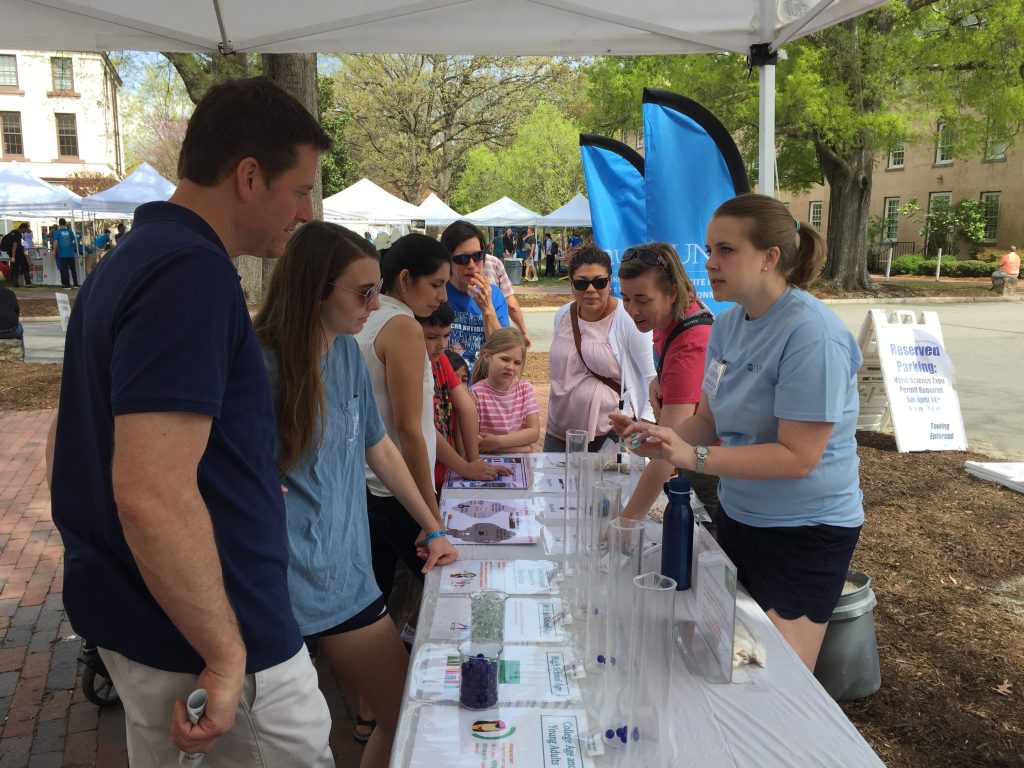IE exhibit explores e-cigarettes, flavorings and the toxicology of vaping at annual UNC Science Expo
May 4, 2018
Amid stations of matching smells to graphics, blowing bubbles and building molecules out of candy, families and children were learning about the science behind a serious emerging public health issue in the United States—vaping. Vaping is the act of inhaling vapors, usually nicotine plus e-liquid known as “flavorant,” from an e-cigarette. The UNC Institute for the Environment’s Environmental Resource Program (ERP) hosted an exhibit at Morehead Planetarium and Science Center’s annual UNC Science Expo on April 14 to communicate what is known about the safety of this relatively new practice.
This year’s theme, the Science of Food and Drink, charged exhibitors to educate the community on research related to things we ingest. Although vaping is not a food or drink, its popularity is associated with flavorings that are food-like, such as fruit, candy and desserts.
“One of the things that makes e-cigarettes attractive is the flavorings,” said Megan Hughes, a research associate at the Institute’s ERP. “We were trying to get people to think about the flavors that you eat on a daily basis—like butter, peppermint, vanilla—those are chemical compounds—naturally occurring or artificial. We know that they are relatively safe to ingest, but we don’t know about the safety of inhaling them, especially inhaling them deep in our lungs, which is what an e-cigarette does. It turns everything into an aerosol so that it is easily inhaled.”
In one activity, participants were asked to match smells to the corresponding image, which gave the exhibit team the opportunity to get the participants to think about the chemical compounds in flavors. In another, children and families learned about chemical compounds by building a diacetyl molecule. Diacetyl is butter flavoring and is made up of carbon, hydrogen and oxygen. Another station taught participants about the basics of toxicology through sorting compounds such as water, sugar, salt, botulism and others into poison or non-poison categories. Participants learned that the dose and the route of exposure is what makes the poison. They also could look at actual e-cigarette devices and talk to presenters about some of the health concerns that come with vaping.
“We know diacetyl is fine to swallow. When we go to the movies, we put butter on our popcorn. But, we don’t think it is okay to inhale,” Hughes explained. “Any one of those things in sufficient quantities can be harmful to our bodies.”
Other visuals in the exhibit shared facts about what is known about e-cigarettes. Because e-cigarettes have only been in the United States for the last decade, there has not been adequate time to conduct public health studies on the safety of using them. The flavorings also contain nicotine, which is addictive.
“We have to rely on the best science that we have right now,” Hughes said. “Throughout the day, we used the expression, ‘we still have a lot to learn.’ We use language to communicate that uncertainty. There are plenty of sources online that tell you that e-cigarettes are safe—it’s just water vapor. Should e-cigarettes be recommended as smoking cessation devices? The answer is maybe, for some groups. So, we were really careful with our phraseology.”
Hughes and her team worked with UNC’s Dr. Ilona Jaspers, who recently began to focus her research on the health effects of vaping. Throughout the day ERP team members, student workers and graduate students in Jaspers’ lab were on hand to assist with activities and answer questions from visitors.
Jaspers is involved with the Center for Environmental Health and Susceptibility at the Gillings School of Global Public Health and deputy director for the Center for Environmental Medicine, Asthma and Lung Biology. Over the past decade, she has studied the effects of smoking, air pollution and nutrition on the respiratory tract. More recently, her research on the health effects of e-cigarettes has made key contributions to, what is still, a limited body of knowledge on vaping.
“Science communication is about educating people with the facts so that they can make their own decisions about a risky behavior,” said Hughes. “Because e-cigarettes haven’t been around for very long, and they are widely used, there is an assumption that they must be safe. It is more complicated than that.”
A survey station prompted participants to put a blue marble in a glass tube if they had tried vaping or had seen anyone vaping. If they had not, they put a clear marble in the tube. The tubes were overwhelmingly blue, signifying awareness of the emerging prevalence of vaping. The marble activity results are consistent with the findings of a 2015 North Carolina Youth Tobacco Survey, which reported a 888% increase in the use of e-cigarettes among North Carolina high school students between 2011 and 2015.
The final activity was blowing bubbles.
“The best thing for children to put into the air is bubbles,” Hughes said.


